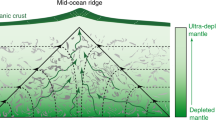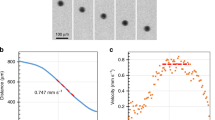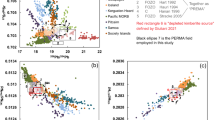Abstract
Although water is only present in trace amounts in the suboceanic upper mantle, it is thought to play a significant role in affecting mantle viscosity, melting and the generation of crust at mid-ocean ridges. The concentration of water in oceanic basalts1,2 has been observed to stay below 0.2 wt%, except for water-rich basalts sampled near hotspots and generated by ‘wet’ mantle plumes3,4,5. Here, however, we report unusually high water content in basaltic glasses from a cold region of the mid-ocean-ridge system in the equatorial Atlantic Ocean. These basalts are sodium-rich, having been generated by low degrees of melting of the mantle, and contain unusually high ratios of light versus heavy rare-earth elements, implying the presence of garnet in the melting region. We infer that water-rich basalts from such regions of thermal minima derive from low degrees of ‘wet’ melting greater than 60 km deep in the mantle, with minor dilution by melts produced by shallower ‘dry’ melting—a view supported by numerical modelling. We therefore conclude that oceanic basalts are water-rich not only near hotspots, but also at ‘cold spots’.
This is a preview of subscription content, access via your institution
Access options
Subscribe to this journal
Receive 51 print issues and online access
$199.00 per year
only $3.90 per issue
Buy this article
- Purchase on Springer Link
- Instant access to full article PDF
Prices may be subject to local taxes which are calculated during checkout




Similar content being viewed by others
References
Danyushevsky, L. V. The effect of small amounts of H2O on crystallisation of mid-ocean ridge and backarc basin magmas. J. Volcanol. Geotherm. Res. 110, 265–280 (2001)
Michael, P. J. The concentration, behavior and storage of H2O in the suboceanic upper mantle — Implications for mantle metasomatism. Geochim. Cosmochim. Acta 52, 555–566 (1988)
Nichols, A. R. L., Carroll, M. R. & Hoskuldsson, A. Is the Iceland hot spot also wet? Evidence from the water contents of undegassed submarine and subglacial pillow basalts. Earth Planet. Sci. Lett. 202, 77–87 (2002)
Asimow, P. D., Dixon, J. E. & Langmuir, C. H. A hydrous melting and fractionation model for mid-ocean ridge basalts: Application to the Mid-Atlantic Ridge near the Azores. Geochem. Geophys. Geosyst. 5, Q01E16, doi:10.1029/2003GC000568 (2004)
Dixon, J. E. & Clague, D. A. Volatiles in basaltic glasses from Loihi Seamount, Hawaii; evidence for a relatively dry plume component. J. Petrol. 42, 627–654 (2001)
Dixon, J. E. & Stolper, E. M. An experimental study of water and carbon dioxide solubilities in mid-ocean ridge basaltic liquids. 2. Applications to degassing. J. Petrol. 36, 1633–1646 (1995)
Klein, E. M. & Langmuir, C. H. Global correlations of ocean ridge basalt chemistry with axial depth and crustal thickness. J. Geophys. Res. 92, 8089–8115 (1987)
Taylor, B. & Martinez, F. Back-arc basin basalt systematics. Earth Planet. Sci. Lett. 210, 481–497 (2003)
Schilling, J. G. Azores mantle blob: The rare-earth evidence. Earth Planet. Sci. Lett. 24, 103–105 (1975)
Bonatti, E. Not so hot “hot spots” in the oceanic mantle. Science 250, 107–111 (1990)
Bonatti, E., Seyler, M. & Sushevskaya, N. A cold suboceanic mantle belt at the Earth's equator. Science 261, 315–320 (1993)
Schilling, J. G. et al. Thermal structure of the mantle beneath the equatorial mid-Atlantic ridge—Inferences from the spatial variation of dredged basalt glass compositions. J. Geophys. Res. 100, 10057–10076 (1995)
Bonatti, E. et al. Steady-state creation of crust-free lithosphere at cold spots in mid-ocean ridges. Geology 29, 979–982 (2001)
Fox, P. J. & Gallo, D. The tectonics of ridge transform intersections. Tectonophysics 104, 204–242 (1984)
Hirth, G. & Kohlstedt, D. L. Water in the oceanic upper mantle: Implications for rheology, melt extraction and the evolution of the lithosphere. Earth Planet. Sci. Lett. 144, 93–108 (1996)
Braun, M. G., Hirth, G. & Parmentier, E. M. The effect of deep damp melting on mantle flow and melt generation beneath mid-ocean ridges. Earth Planet. Sci. Lett. 176, 339–356 (2000)
Asimow, P. D. & Langmuir, C. H. The importance of water to oceanic mantle melting regimes. Nature 421, 815–820 (2003)
Katz, R. F., Spiegelman, M. & Langmuir, C. H. A new parameterization of hydrous mantle melting. Geochem. Geophys. Geosyst. 4, 1073, doi:10.1029/2002GC000433 (2003)
Gast, P. Trace element fractionations and the origin of tholeiitic and alkaline magma types. Geochim. Cosmochim. Acta 32, 1057–1086 (1968)
Shen, Y. & Forsyth, D. W. Geochemical constraints on initial and final depths of melting beneath mid-ocean ridges. J. Geophys. Res. 100, 2211–2237 (1995)
Hellebrand, E., Snow, J. E., Dick, H. J. B. & Hofmann, A. W. Coupled major and trace elements as indicators of the extent of melting in mid-ocean-ridge peridotites. Nature 410, 677–681 (2001)
Ellam, R. M. Lithospheric thickness as a control on basalt geochemistry. Geology 20, 153–156 (1992)
McKenzie, D. & O'Nions, R. K. Partial melt distributions from inversion of rare earth element concentrations. J. Petrol. 32, 1021–1091 (1991)
Hellebrand, E., Snow, J. E., Hoppe, P. & Hofmann, A. W. Garnet-field melting and late-stage refertilization in “residual” abyssal peridotites from the central Indian ridge. J. Petrol. 43, 2305–2338 (2002)
Christie, D. M., West, B. P., Pyle, D. G. & Hanan, B. B. Chaotic topography, mantle flow and mantle migration in the Australian-Antarctic discordance. Nature 394, 637–644 (1998)
Michael, P. J. et al. Magmatic and amagmatic seafloor generation at the ultraslow-spreading Gakkel ridge, Arctic Ocean. Nature 423, 956–961 (2003)
Ottolini, L., Bottazzi, P., Zanetti, A. & Vannucci, R. Determination of hydrogen in silicates by secondary ion mass spectrometry. Analyst 120, 1309–1314 (1995)
Phipps Morgan, J. & Forsyth, D. W. Three-dimensional flow and temperature perturbations due to a transform offset: Effects on oceanic crustal and upper mantle structure. J. Geophys. Res. 93, 2955–2966 (1988)
DeMets, C., Gordon, R. G., Argus, D. F. & Stein, S. Effect of recent revisions to the geomagnetic reversal time scale on estimates of current plate motions. Geophys. Res. Lett. 21, 2191–2194 (1994)
Anders, E. & Grevesse, N. Abundances of the elements: Meteoritic and solar. Geochim. Cosmochim. Acta 53, 197–214 (1989)
Acknowledgements
We thank D. Brunelli for comments, and D. W. Forsyth for providing programs for temperature calculations. This work was supported by the Italian Consiglio Nazionale Ricerche, the US National Science Foundation and the EUROMARGINS programme.
Author information
Authors and Affiliations
Corresponding author
Ethics declarations
Competing interests
The authors declare that they have no competing financial interests.
Supplementary information
Supplementary Table
This table shows average chemical parameters obtained from basaltic glasses sampled along the eastern Romanche Ridge segment. (DOC 42 kb)
Supplementary Discussion
This provides a detailed description of the numerical modelling used. (DOC 2770 kb)
Rights and permissions
About this article
Cite this article
Ligi, M., Bonatti, E., Cipriani, A. et al. Water-rich basalts at mid-ocean-ridge cold spots. Nature 434, 66–69 (2005). https://doi.org/10.1038/nature03264
Received:
Accepted:
Issue Date:
DOI: https://doi.org/10.1038/nature03264
This article is cited by
-
Multi-stage melt impregnation and magma–seawater interaction in a slow-spreading oceanic lithosphere: constraints from cumulates in the Lagkorco ophiolite (central Tibet)
Contributions to Mineralogy and Petrology (2022)
-
Generation and evolution of the oceanic lithosphere in the North Atlantic
La Rivista del Nuovo Cimento (2022)
-
High H2O Content in Pyroxenes of Residual Mantle Peridotites at a Mid Atlantic Ridge Segment
Scientific Reports (2020)
-
High water content in primitive mid-ocean ridge basalt from Southwest Indian Ridge (51.56ºE): Implications for recycled hydrous component in the mantle
Journal of Earth Science (2017)
-
Extreme mantle uplift and exhumation along a transpressive transform fault
Nature Geoscience (2016)
Comments
By submitting a comment you agree to abide by our Terms and Community Guidelines. If you find something abusive or that does not comply with our terms or guidelines please flag it as inappropriate.



